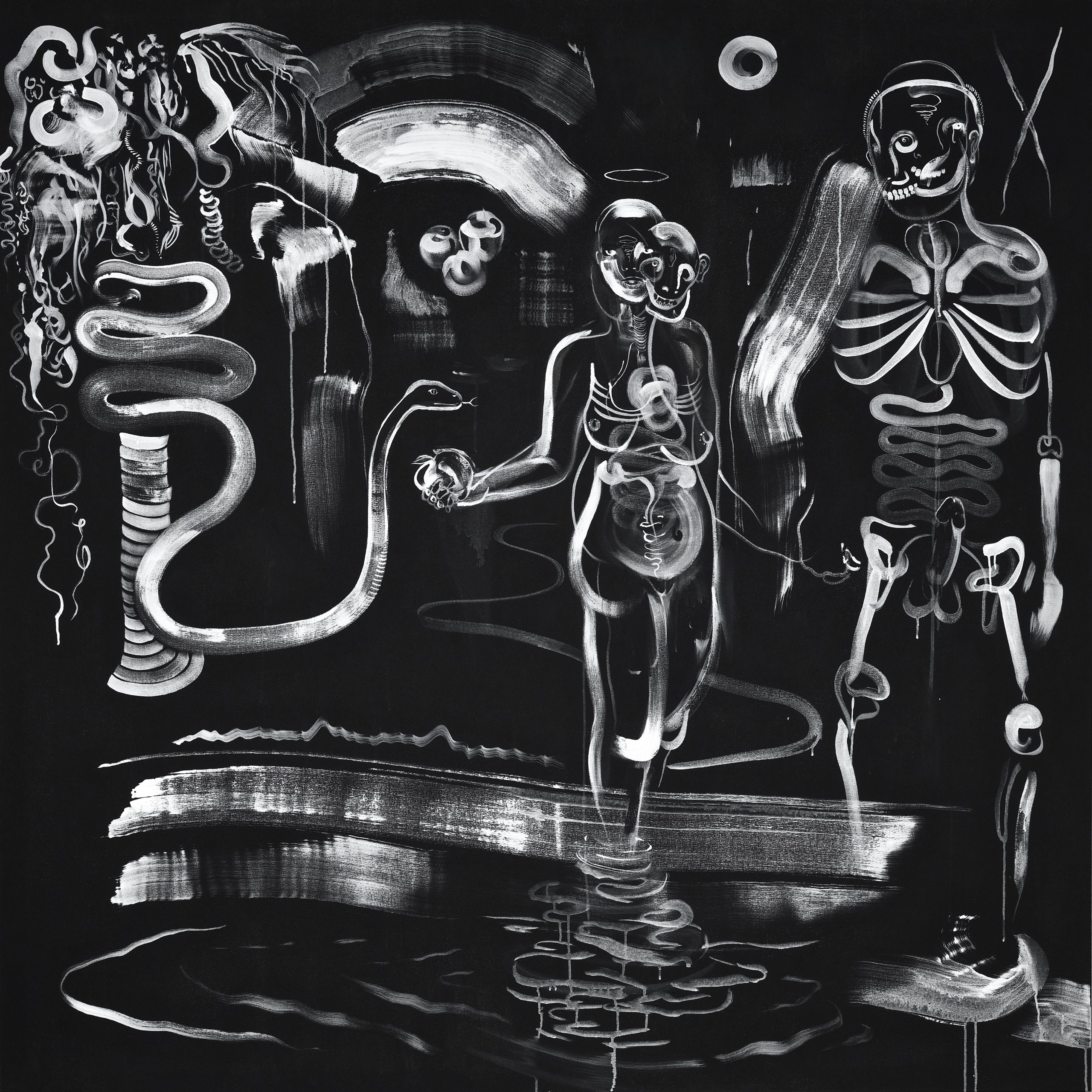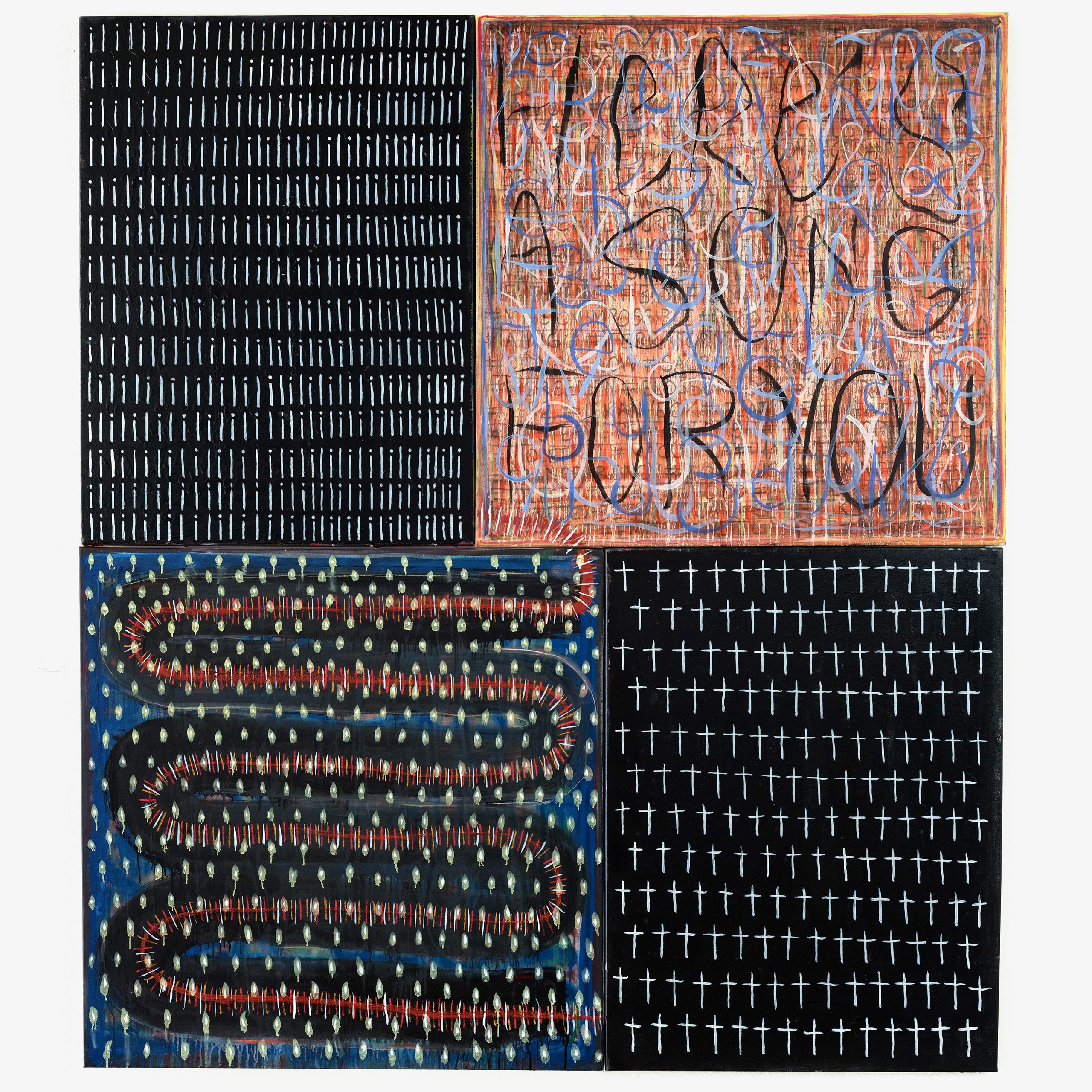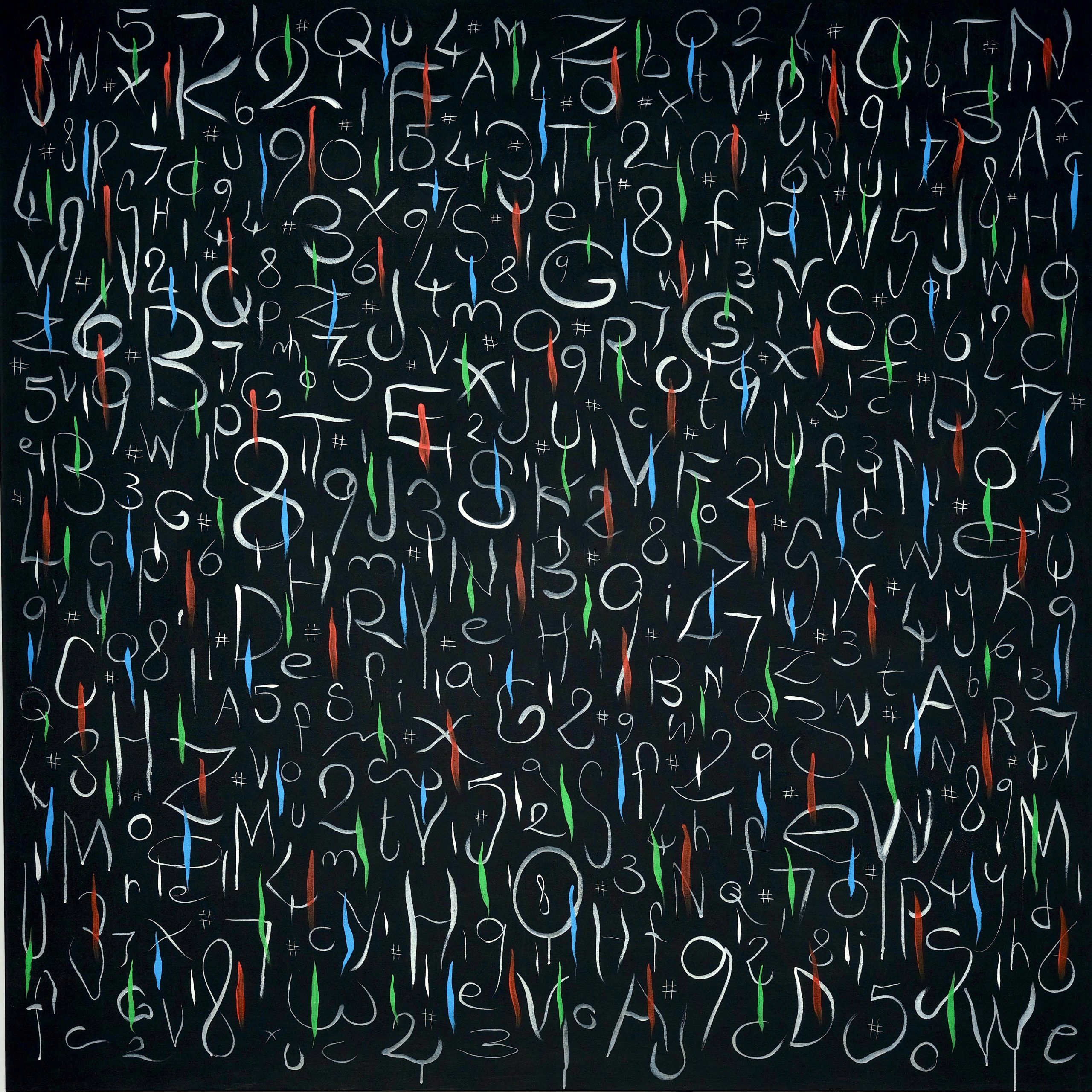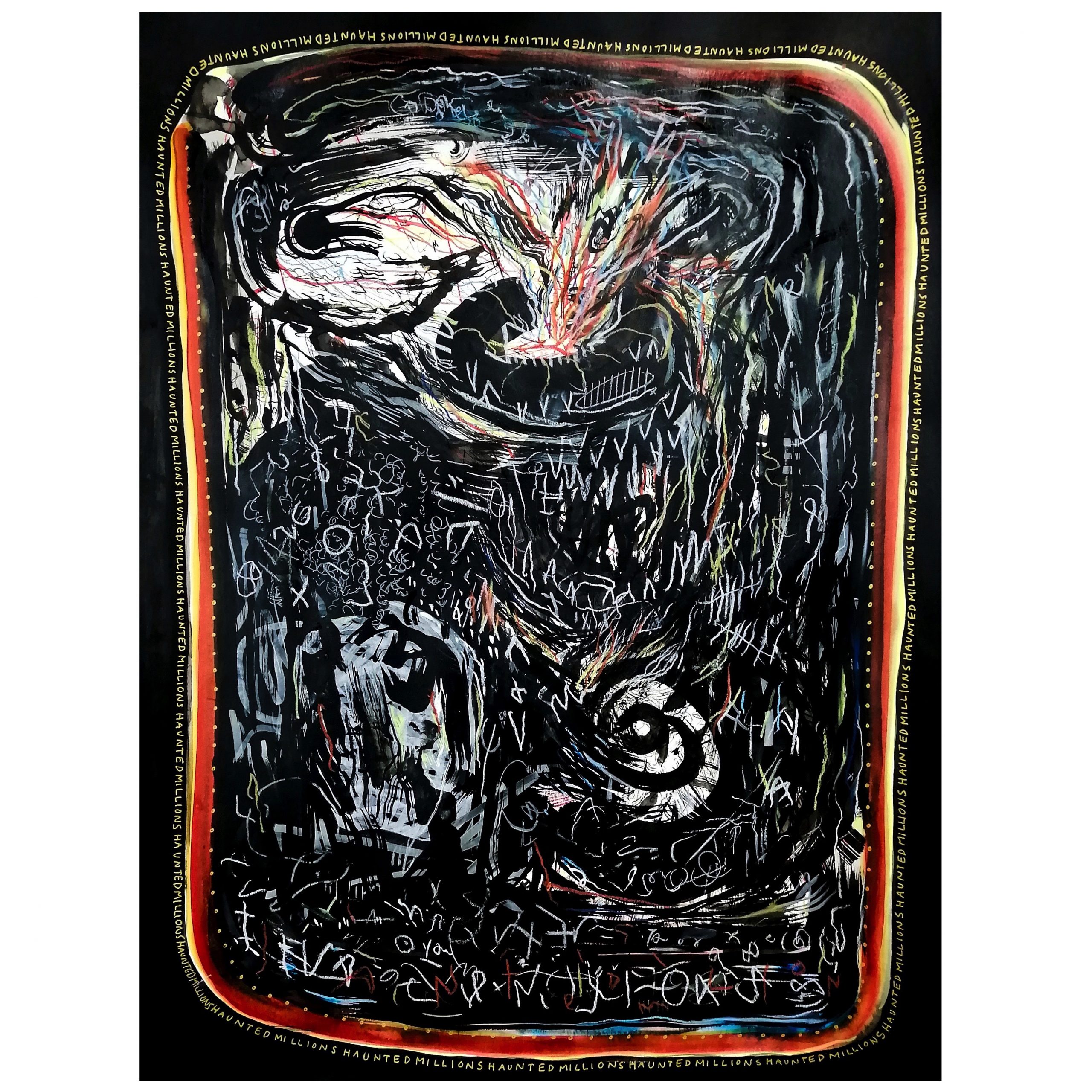This past weekend I attended a walk-about at The Mixed Reality Workshop (TMRW) Gallery, for Fred Clarke’s solo exhibition titled Cognoscenti — and while I’ve engaged with the sonic fabulations Clarke magics into being with the music he produces under the moniker Mathroom, it was quite something else to experience his visual creations materialised through mixed media. In thinking through, with and about Cognoscenti for the writing of this piece, I found myself having difficulty placing the word exhibition alongside it because of the term’s relationship with words such as presentation, demonstration and even show. Words to me that suggest both a passive and unilateral relationship of engagement or exchange. So much can get lost in translation, leak out through the pores — even in the translation of an experience and its sensory and affective impact into the coherency of language. Cognoscenti and the conceptual, thematic and affective space of artistic and philosophical inquiry fabricated by Clarke through and with it, lives in this space of porosity. The exhibition text announces it as “a spectral range of questions, a gauntlet of the paradox that explores the concept of knowledge, its origins and structural constitution”.

Cognoscenti
Clarke proposes that the possibility of investigation and symbolic descriptors and definitions of knowledge propagation are subject to revisal, mutation and ultimate entropy. Mildly referencing the book of Genesis, in its symbolism and archetypal portrayal of the inception point of knowledge. What exactly is knowledge? Is a story knowledge? Is a dream knowledge? Or is knowledge bound to legitimised forms of academia? Or cultural practices? In each instance, strong arguments for and against the legitimacy of knowledge exists, leaving it in many ways as an ambiguous key to our conscious experience.
The very matter of inquiry that lies at the crux of Cognoscenti’s metaphysical meditations and provocations suggests that how it is experienced and how it moves and works its way through us cannot be predetermined — will be different in its own subjective way with each individual encounter. Much like the many faces of Truth. I spoke to multidisciplinary artist Fred Clarke to further delve into Cognoscenti, his process and other musings.

Mirror Mirror
So I only read the exhibition text when I got back home after the walk-about on Saturday — I find it difficult to build my own relationship with and find my own questions for the work if I’ve engaged with its text before. I found it interesting that the text announces the exhibition as “a spectral range of questions, a gauntlet of the paradox that explores the concept of knowledge, its origin and structural constitution”. This idea of a spectral range of questions or that of a gauntlet of paradoxes resonated with my own engagement with and visual, affective and sensory taking in of the exhibition. It felt less like something was being shown as the word exhibition alludes to, and more like algorithms, provocations, visual and audio streams of consciousness and questioning, half finished thoughts and partially remembered dreams — the echoes of our collective unconscious working together in the space and with whatever/whomever is also moving through it to question matters of existence. However, the inquiry feels philosophical — matters of metaphysical questioning — more than it is about finding concrete answers as would be the case with a mathematical theorem. Can you tell me more about how positioning the show in the space of questioning came about?
It’s always reaffirming to know that creations can speak for themselves, and translate intention, albeit abstractly, without a framework of literal text to complete their meaning and essence. In terms of the exhibition’s Cognoscenti concept, and my general position as an artist, I feel far less equipped to provide solutions or answers to life and it’s complexities than to create spaces of inquisition. It’s also simply more enjoyable/exciting. There’s something about the white belt approach to anything, no matter the number of prior rodeos, that seems to hold energy and humility in the creative process. With respect to universal mystery, it appears to be a treadmill paradox of more knowledge being less, and a humour that results. It’s something I aspire towards — and [which] hopefully allows for multiple angles of opinion and interpretation when engaging with the work. I do have my own meaning and intention for the artworks, but this doesn’t need to be a rigid structure, and I enjoy when others evolve and expand the meaning in a natural way. It’s all silly putty.

iI
In your paintings and drawings there seems to be this hieroglyphics or code of symbolism you develop; almost like an alphabet or language system of sorts — someone else could say equations. Language and scientific inquiry both work to serve the purpose of questioning and attempting to arrive at some kind of truth, language we know is not objective but radioactive with its own politics and histories (Lacan speaks of truths rather than a truth) where science is assumed to be universally objective. Because your mark-made-code can be read as both a language system or equations — was there an intentional effort to play in this space and tension of objectivity vs. subjectivity, universal vs. singular truth?
Certainly, these dynamics of truth-truths, subjective-objective, singular-universal are fascinating and taunting, like an itch that demands scratching for our species. It seems that with a fast-paced globalised short-hand internet culture, language (at least my experience of English) is refracting/mutating and at times feels a bit like a flat tyre on a vehicle, pulling to the side. At the core these numbers and symbols are tools, in combination they unlock a spectrum of communication possibilities. It is always evolving; beyond any individual or collective control. Language is a force of nature. We see this in most — if not all other species — even in very subtle and minimal ways. There’s something about brevity, less talk more feel, less mind more heart, less past/future, that feels like a valuable tool going forward. Closer to nature. If the human species is blowing up in numbers, definitions, and information technology, the cultivation of stillness feels important. I’m more interested in the first dimension than the others, even as a lighthearted excuse to be simple.

La Santa
I always think that the form(s) of things allow us different ways of thinking through/with and thus different possibilities. Just as the body is a form, and thinking through/with it reveals something else to the possibilities of cognitive thinking — Cognoscenti is mixed media in form, finding shape in paintings, drawings, sound, video collage etc. While producing the works themselves, did each individual form offer you something the other couldn’t, or was it really just about wanting to play around with different materials?
Each medium has a particular range and frequency, like instruments, they cover a range of tone and colour; a violin can’t sound like tuba and the same applies to visual mediums. That said, I think and find that no matter the instrument the same level of raw frequency can be expressed — no matter how big or small — and still the difference in medium helps different forms, and sometimes defines them. I was fortunate to see some of the great contemporary paintings in a Los Angeles museum last year, which both amazed and inspired me to paint on a large scale. In some instances size does matter, and it was exciting to go big, something I’d like to continue to explore. I wanted to paint in part for the TMRW show because as a tech based space, to include the older analog/handmade mediums as a legitimate and timeless technology felt important. They arguably still hold more frequency and meaning than impressive but generic digital forms. A hand made mark of any kind is very personal and primal, there is only one handwriting by you. The human body is a fascinating vessel, in terms of how much information it holds, both discovered and unknown. All language, as far as we know (which is relative) is born from out of human forms. The thought that we contain; the codes for everything that has manifested to date is astounding. It makes me wonder if it’s all contained in our DNA, or if we act more as vessels, like computers, streaming omnipresent information from a universal internet.

Thought
You mentioned during the walk-about that some of the works were actually created at TMRW which I think is really cool, I think space also has its own relationship with feeling, memory and what unfolds or is held within it — how was the experience and process of creating in the exhibition space?
It’s is rare I think that a gallery gives the space and option to become a studio or creation hub before an exhibition. I’m very thankful to TMRW for this experience. It’s a bit like a home-cooked meal vs off site delivery, neither better than the other, just different — essentially food is food, place is interchangeable. There was something about the neutrality of the space , the support and excitement for the project and the general feeling of freedom to express without structures, that really helped form this body of work — specifically the large paintings. Art can manifest in unlikely places, the right ingredients can often appear in bizarre or mundane forms. Personally it’s about intention and space and not so much [in the physical] in terms of props and extras but rather, energetically. It can happen anywhere.

Haunted Millions
Can you unpack the relationship between the paintings, drawings and the video album a bit?
The exhibition is made up of select works made at different times and in different spaces. In many ways the Angel album project informed the 5 large paintings, made at TMRW and the remaining work was made last year in LA and at home, and fitted with the theme of this show. The crossover concepts in video/music and drawn/painted works are to do with knowledge, archetypes, coding, chaos, and the collective human experience. I’m continually unpacking this, on personal and creative levels. When I make things the content feels not entirely from self [but more like] wandering and wondering through different perspectives that are not necessarily my own — or at least this is the game of imagination; an engine of perspective that unlocks different and new things. Although I do in this case elaborate on the work through language, sometimes more can be absorbed and understood without a single word being spoken. In life I try to keep things succinct, and listen more, which is easier said than done. [I] find music and silent visuals to often say things better than language itself. In this way the exhibition has an element of irony, as I imagine any attempt at unpacking and questioning these abstract and universal themes tends to do.
* Cognoscenti is available to view both on and offline at TMRW gallery.

One Day

Together



















































